Summary:
- Despite reporting a solid double beat for Q4 FY23, Microsoft’s stock has tumbled by ~6% over the last few sessions after FY24 guidance failed to meet lofty investor expectations.
- Even at ~$335 per share, MSFT stock trades at an elevated P/E multiple of ~35x and currently sports a negative equity risk premium (FCF yield < risk-free treasury yield).
- Based on TQI’s Valuation Model, Microsoft’s stock offers highly unfavorable risk/reward for long-term investors (despite use of pretty generous growth and margin assumptions).
- In light of Q4 FY23 earnings, I continue to rate MSFT a “Sell”.
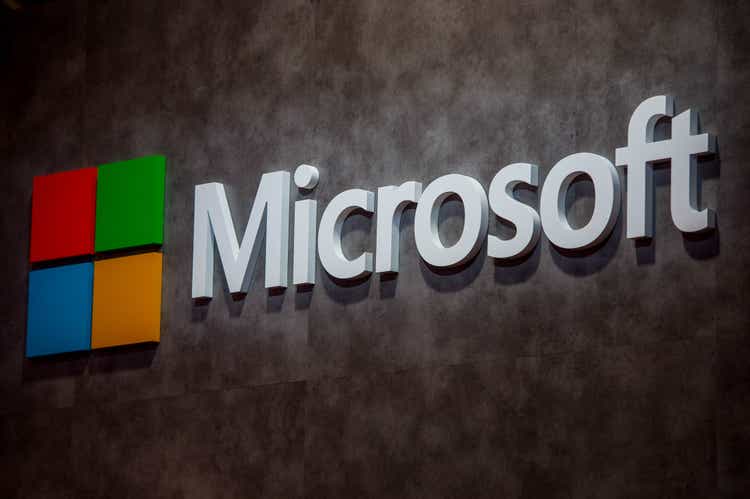
David Ramos
Brief Review Of Microsoft’s Q4 FY2023 Report
In Q4 FY23, Microsoft Corporation (NASDAQ:MSFT) delivered total revenue of $56.2B (up +8% y/y), with broad strength across its business segments. In addition to a $700M beat on the top line, Microsoft also beat consensus EPS estimates by 14 cents.
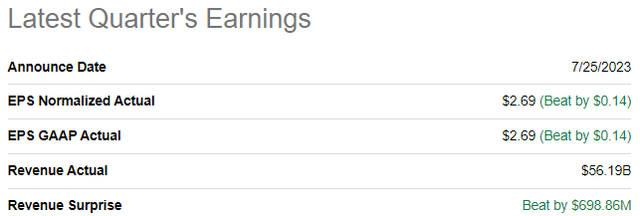
SeekingAlpha
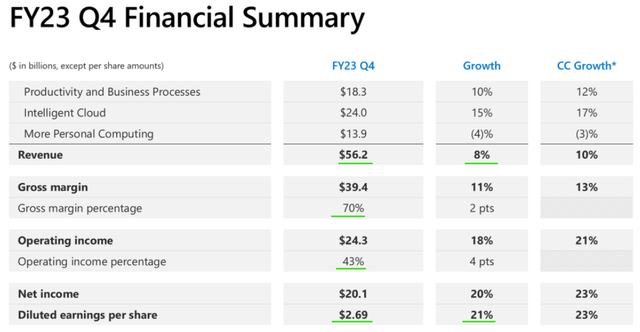
Microsoft Q4 FY23 Earnings Presentation
All three of Microsoft’s business segments – Productivity & Business Processes, Intelligent Cloud, and More Personal Computing – outperformed management expectations in Q4 FY23:
| Q4 FY23 Guidance | Q4 FY23 Actual Revenue | Result | |
| Productivity & Business Processes | $17.9B to $18.2B | $18.3B | Beat |
| Intelligent Cloud | $23.6B to $23.9B | $24.0B | Beat |
| More Personal Computing | $13.35B to $13.75B | $13.9B | Beat |
Earlier this year, Microsoft exercised its pricing power by raising the subscription fees for its cloud services such as Office 365, and those increases are having a positive impact on the “Productivity & Business Processes” and “Intelligent Cloud” segments. While the “More Personal Computing” segment remains under pressure due to macroeconomic factors, the PC market seems to be bottoming here, and this segment looks set for a gradual recovery in the near future.
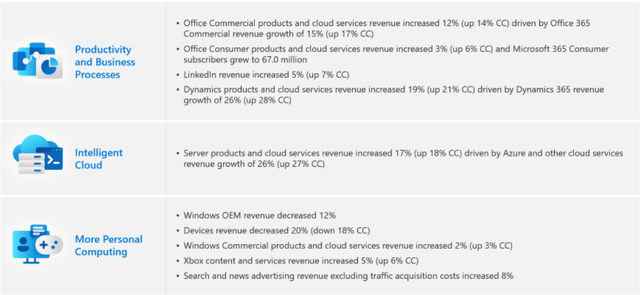
Microsoft Q4 FY23 Earnings Presentation
Microsoft’s Azure Cloud business stood out once more in the latest quarter, experiencing significant growth of 26% y/y at an annual run-rate of ~$60B. Though the rate of Azure’s revenue growth has been slowing down, it continues to gain market share, as stated by Satya Nadella during the Q4 FY23 earnings conference call. Looking ahead, the introduction of generative AI is expected to keep Azure as the key growth driver for Microsoft in the foreseeable future.
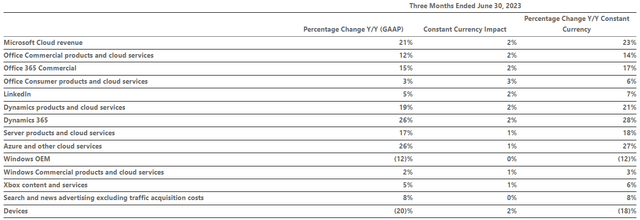
Microsoft Q4 FY23 Earnings Press Release
As we know, Microsoft has been making aggressive moves to increase market share in Search via AI-powered Bing. While Microsoft management highlighted positive usage trends, Search & News advertising revenues grew by only ~8% y/y in Q4, despite a recovery in the digital advertising market [both Alphabet (GOOGL) and Meta (META) reported stronger-than-expected advertising numbers]. Furthermore, global traffic data shows that Google has been gaining market share since the new AI-powered Bing came out earlier this year. While artificial intelligence may enable Microsoft to gain a larger piece of the Search advertising pie in the future, there’s no evidence to support this view.
During Q4 FY23, Microsoft’s operating expenses growth slowed to 2% y/y while revenue growth rates re-accelerated to +8% y/y. Consequently, Microsoft’s quarterly free cash flow growth returned to positive territory (+12% y/y). In Q4, Microsoft generated $19.8B in free cash flow and returned $9.7B to its shareholders in the form of share repurchases ($4.6B) and dividends ($5.1B).
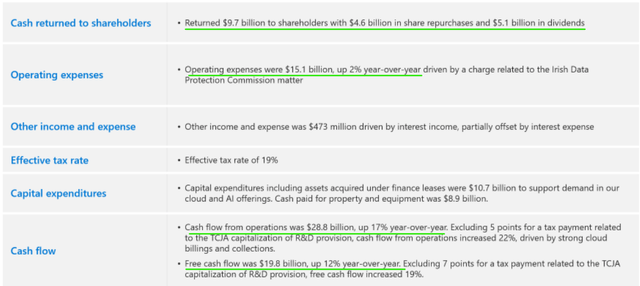
Microsoft Q4 FY23 Earnings Presentation
Despite ongoing macroeconomic uncertainties, Microsoft has showcased resilience with revenues re-accelerating back to high single digits in recent quarters. In my view, Microsoft’s Q4 report was a solid double beat. Now, let’s re-evaluate MSFT’s risk/reward.
Microsoft’s Fair Value And Expected Returns
Back in January 2023, I switched from a “Hold” to a “Sell” rating on Microsoft due to its extremely bloated valuation. And boy, I have been wrong all year, with MSFT stock rallying ~40% year-to-date. Here’s my recent work on Microsoft:
- Microsoft Q3 Earnings Review: Solid Report, Valuation Premium Remains Unjustified – Sell
- Microsoft Q2 Review: You Were Warned
- Microsoft Stock: You Have Been Warned By Satya Nadella
While MSFT stock has rallied from ~$240 to ~$367 (a new all-time high), I remain unconvinced about this rally because the entirety of this move is driven by trading multiple expansion.
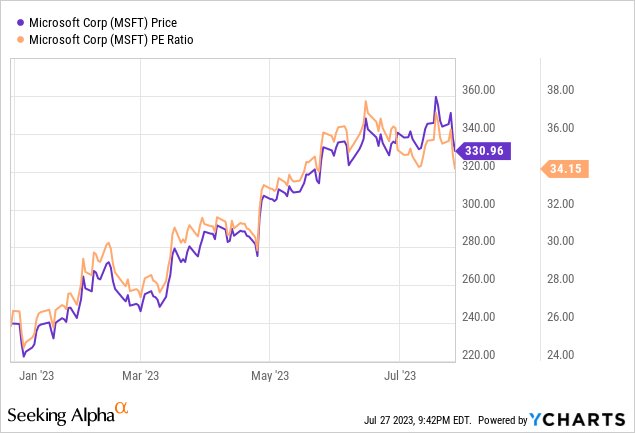
When I rated MSFT a “Sell”, the risk/reward was bad, now it’s gotten worse. Yes, the market is excited about Microsoft’s AI monetization prospects, and rightly so. While I truly believe AI can boost Microsoft’s sales and earnings growth, the monetization is likely to be gradual (and Amy Hood, Microsoft’s CFO said so on the call while discussing guidance for FY24).
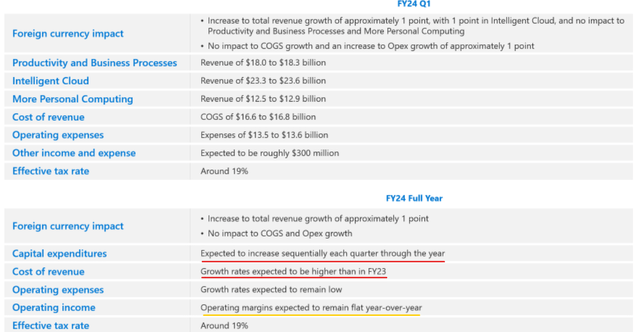
Microsoft Q4 FY23 Earnings Presentation
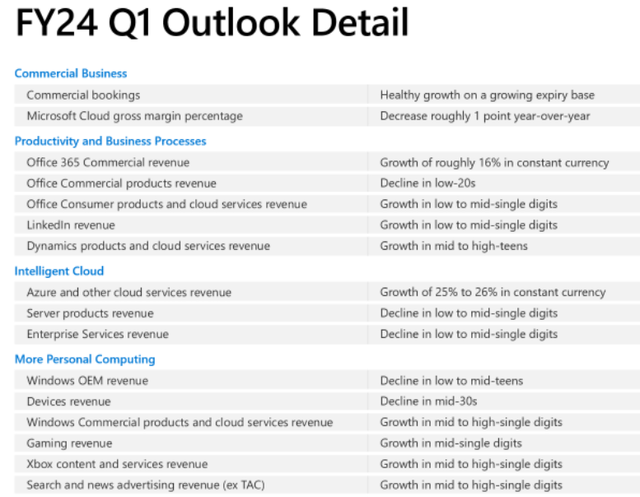
Microsoft Q4 FY23 Earnings Presentation
Despite all the AI hype around Microsoft, it is a mature business that’s set to grow at high-single to low-double-digit rates over the next five years. Unlike Nvidia, Microsoft is not experiencing any sort of explosive growth from AI!
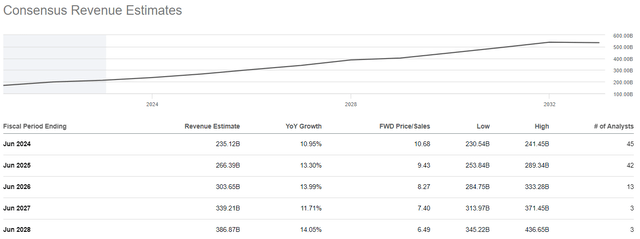
SeekingAlpha
Even after utilizing generous assumptions for growth and margins, Microsoft continues to look significantly overvalued:
According to TQI’s Valuation Model, Microsoft’s fair value is $216.99 per share (or $1.62T). With the stock trading at ~$340 per share, I continue to view MSFT stock as being grossly overvalued at current levels.
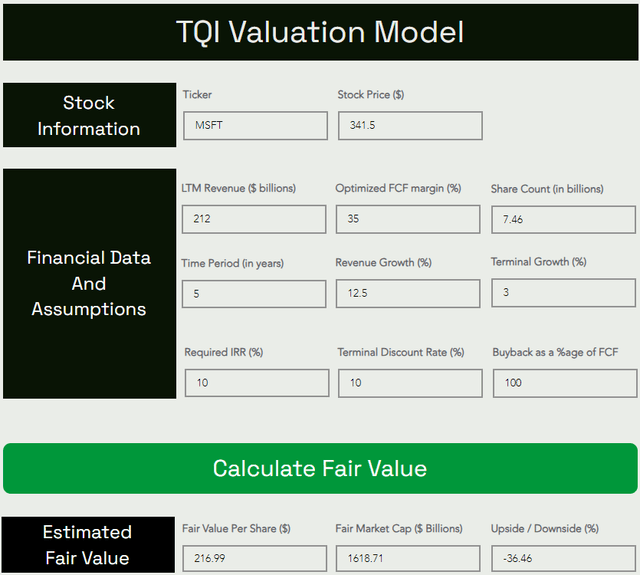
TQI Valuation Model (TQIG.org)

TQI Valuation Model (TQIG.org)
Predicting where a stock would trade in the short term is impossible; however, over the long run, a stock would track its business fundamentals and obey the immutable laws of money. If the interest rates were to stay depressed, higher equity multiples would be justifiable. However, I work with the assumption that interest rates will eventually track the long-term average of ~5%. Inverting this number, we get a trading multiple of ~20x [P/FCF].
Applying this figure as an exit multiple, I see Microsoft stock rising to ~$440 per share by 2027-28 at a CAGR of 5.27%. Since MSFT’s expected return falls well short of my investment hurdle rate of 15% and the S&P 500’s long-term average return of ~10%, I am not a buyer here.
At this point, [risk-free] treasury bonds offer better risk/reward than Microsoft’s stock. In the event of a hard landing, I could see Microsoft retracing to its fair value (and who knows, it could probably overshoot to the downside). Hence, I see a downside risk of 35-50%+ in MSFT stock. Now, I will never short a high-quality business like Microsoft, but if I owned MSFT, I would sell here.
Concluding Thoughts
Microsoft is a robust business (as evidenced by its Q4 FY23 report); however, after a spectacular year-to-date rally the stock is priced for perfection, and despite a post-ER sell-off, MSFT’s risk/reward remains highly unfavorable for investors.
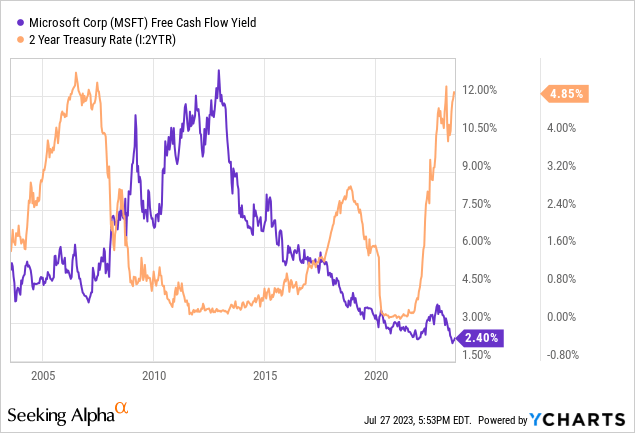
Microsoft is well-positioned to benefit from the secular trend of artificial intelligence; however, a negative risk premium violates the immutable laws of money. In my view, Microsoft is incredibly expensive (at ~35x P/E) in relation to its growth profile [even in a zero-interest rate environment]. And while bulls may disagree, we no longer operate in such an environment, with risk-free US Treasury bonds yielding nearly 4-5%.
With Microsoft’s equity risk premium firmly in the negative territory, the stock offers no margin of safety. Since the turn of the century, we have only seen such negative equity risk premiums for Microsoft during the 2007-08 (Great Financial Crisis) and 2000-2002 (Dot-com Bubble) periods, and we all know what happened with the stock market and Microsoft during and immediately after these periods.
And as we saw in this note, MSFT is grossly overvalued on an absolute basis. Considering Microsoft’s absolute valuation, elevated trading multiples, and negative equity risk premium, I continue to believe that the stock will undergo a painful correction in the near to medium term.
While recent economic data has come in better than expected, leading economic indicators and a deeply inverted yield curve continue to point toward a hard landing. If that happens, Microsoft is likely to retrace back to its fair value, which is ~35% lower than current levels. Given the risk/reward on offer (5-yr expected return of 5.3%), I continue to rate MSFT stock a “Sell” at current levels. This is not a “short sell” recommendation by any means, but if I owned MSFT, I would sell it here.
Key Takeaway: I rate Microsoft a “Sell” in the $330s.
Thank you for reading, and happy investing! If you have any questions, thoughts, and/or concerns, please feel free to share them in the comments section below.
Analyst’s Disclosure: I/we have a beneficial long position in the shares of GOOGL, META either through stock ownership, options, or other derivatives. I wrote this article myself, and it expresses my own opinions. I am not receiving compensation for it (other than from Seeking Alpha). I have no business relationship with any company whose stock is mentioned in this article.
Seeking Alpha’s Disclosure: Past performance is no guarantee of future results. No recommendation or advice is being given as to whether any investment is suitable for a particular investor. Any views or opinions expressed above may not reflect those of Seeking Alpha as a whole. Seeking Alpha is not a licensed securities dealer, broker or US investment adviser or investment bank. Our analysts are third party authors that include both professional investors and individual investors who may not be licensed or certified by any institute or regulatory body.
Are you looking to upgrade your investing operations?
Your investing journey is unique, and so are your investment goals and risk tolerance levels. This is precisely why we designed our marketplace service – “The Quantamental Investor” – to help you build a robust investing operation that can fulfill (and exceed) your long-term financial goals.

